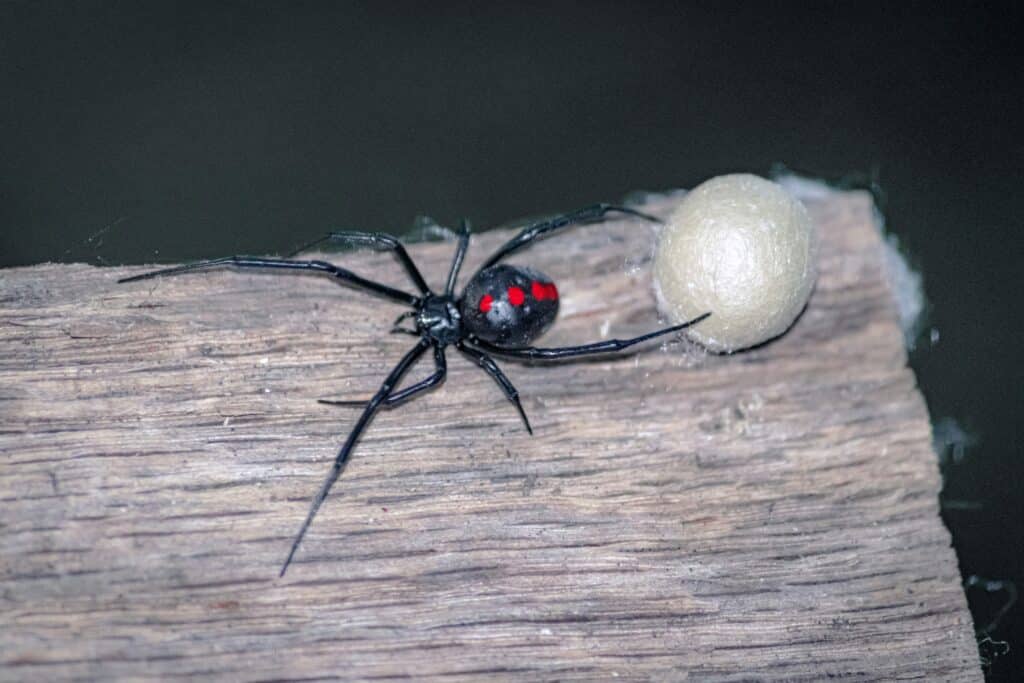Sharing your living space with spiders isn’t unusual, but encountering a black widow spider can cause real concern. These arachnids—identified by their glossy black bodies and bright red hourglass marking—are venomous.
Early detection of a black widow infestation is crucial for the well-being of your household, particularly for young children, older adults, and pets who may be more susceptible to the effects of a bite.
This guide will equip you with the knowledge to identify black widows, recognize signs of infestation, and take the necessary steps for eradication.
The Dangers of Black Widows

Black widows are infamous for their venom, which is estimated to be 15 times stronger than a rattlesnake’s venom. While fatalities from black widow bites are rare, the potential consequences can be severe. Bite symptoms can include intense muscle aches and cramps, nausea, vomiting, and difficulty breathing.
Due to the potential health risks, it’s essential to address a black widow infestation quickly and avoid direct contact with the spiders or their webs. In many cases, getting in touch with professional Exterminators early is the quickest way to ensure your health and safety.
How to Identify Black Widows

What do black widows look like? Here’s what you need to know:
- Adult females, the most commonly encountered variety, are typically a shiny black with a distinct red hourglass marking on the underside of their bulbous abdomen.
- Males are smaller and less frequently seen. They have red and white markings on their abdomens.
- Young black widows start as orange and white, gradually turning black as they mature.
Black widow webs offer another vital clue. These spiders create messy, irregular webs, often constructed near the ground in secluded areas like basements, crawl spaces, garages, or under objects outdoors.
Additionally, the presence of an egg sac—a silken pouch containing hundreds of spider eggs—near potential entry points like doorways is a strong indicator of an infestation.
Signs of Black Widows
While unexpected spider sightings are a clear sign of a potential problem, there are other subtle indicators to be aware of.
Unusual webbing in secluded areas, particularly near the ground level, or the discovery of egg sacs warrants immediate action.
Black widows are shy creatures, and encountering them directly is less common. However, if you do find shed skin—small pieces of brownish or grayish material around potential hiding places—it suggests black widow activity.
Finally, small, pepper-like droppings near webs or harborage areas can indicate infestation.
How to Get Rid of Black Widows

If you suspect a black widow infestation in your home, prioritize safety. Avoid direct contact with the spiders or their webs. The most secure and effective course of action is to contact a professional pest control service. They have the expertise and equipment necessary to effectively identify and eradicate infestations.
Preventing Black Widow Infestations
The best defense against black widows is a proactive approach. Here are some key steps to prevent these spiders from taking up residence in your home:
- Declutter and Clean Regularly: Eliminate potential hiding spots by keeping your home clean and clutter-free. Regular vacuuming and dusting can help reduce spider populations and remove potential prey insects that attract black widows.
- Block Entry Points: Inspect your foundation and exterior walls for cracks or holes and seal them to prevent spiders from entering your home.
- Store Items Strategically: Avoid storing firewood, boxes, or other clutter directly against your home’s exterior. These items create harborage areas for spiders and provide easy access points to your living space.
Think You Have a Black Widow Infestation?
If you suspect a black widow infestation, don’t attempt to handle the situation yourself. Reach out to a qualified pest control professional to effectively eliminate the infestation. Contact Aptive, we’d love to help.









